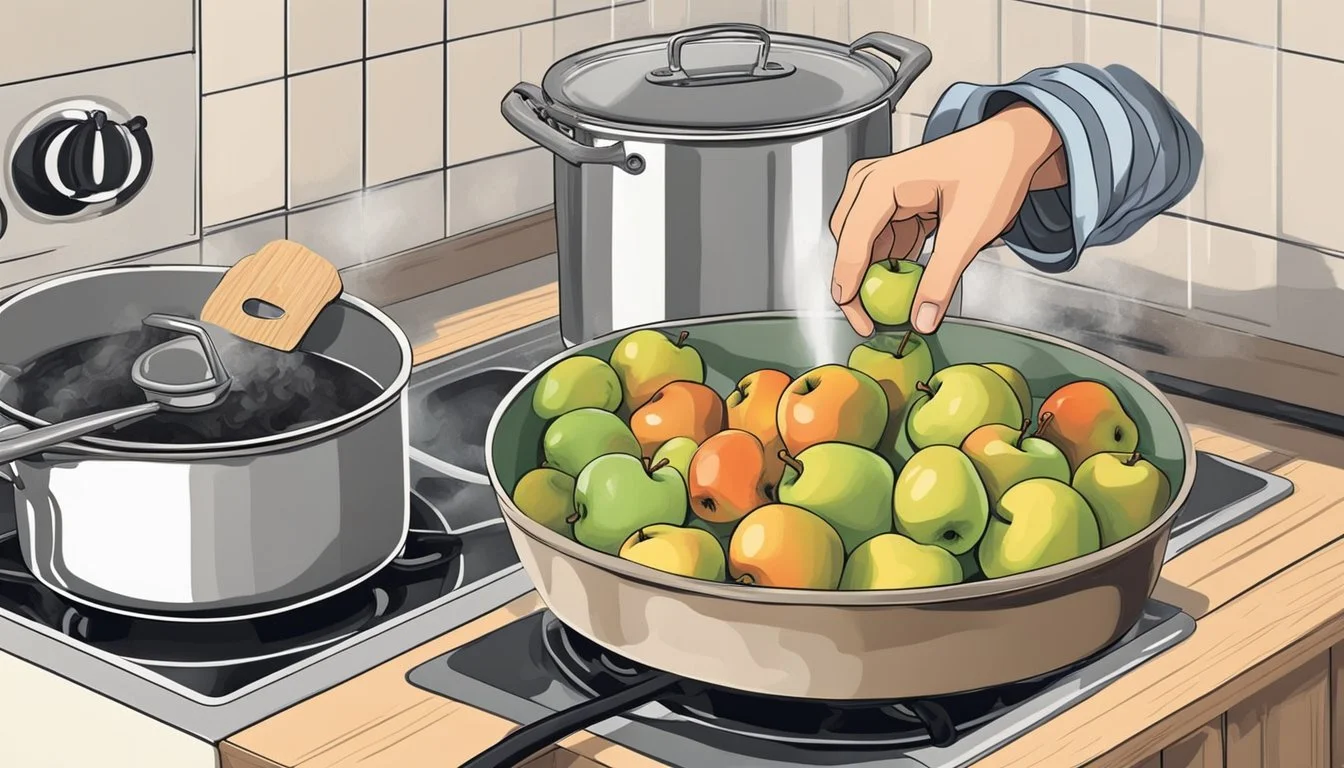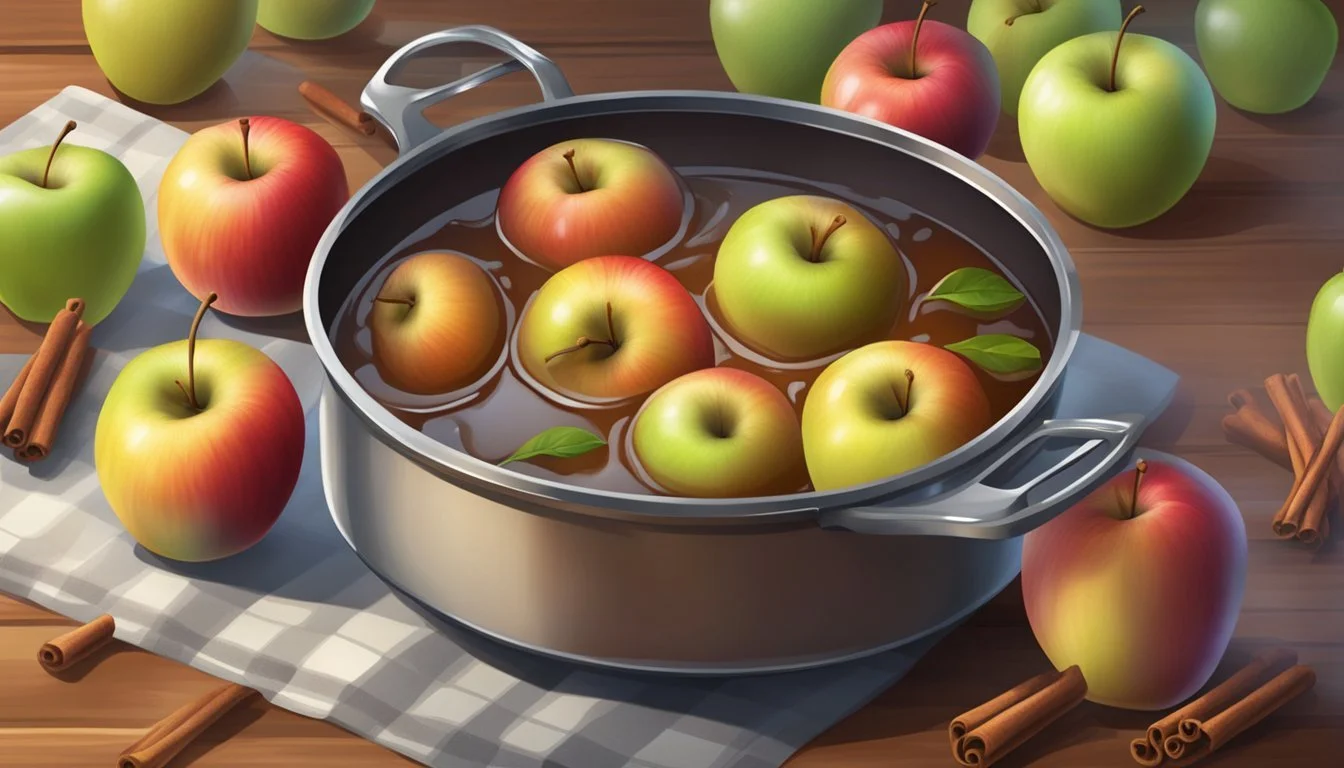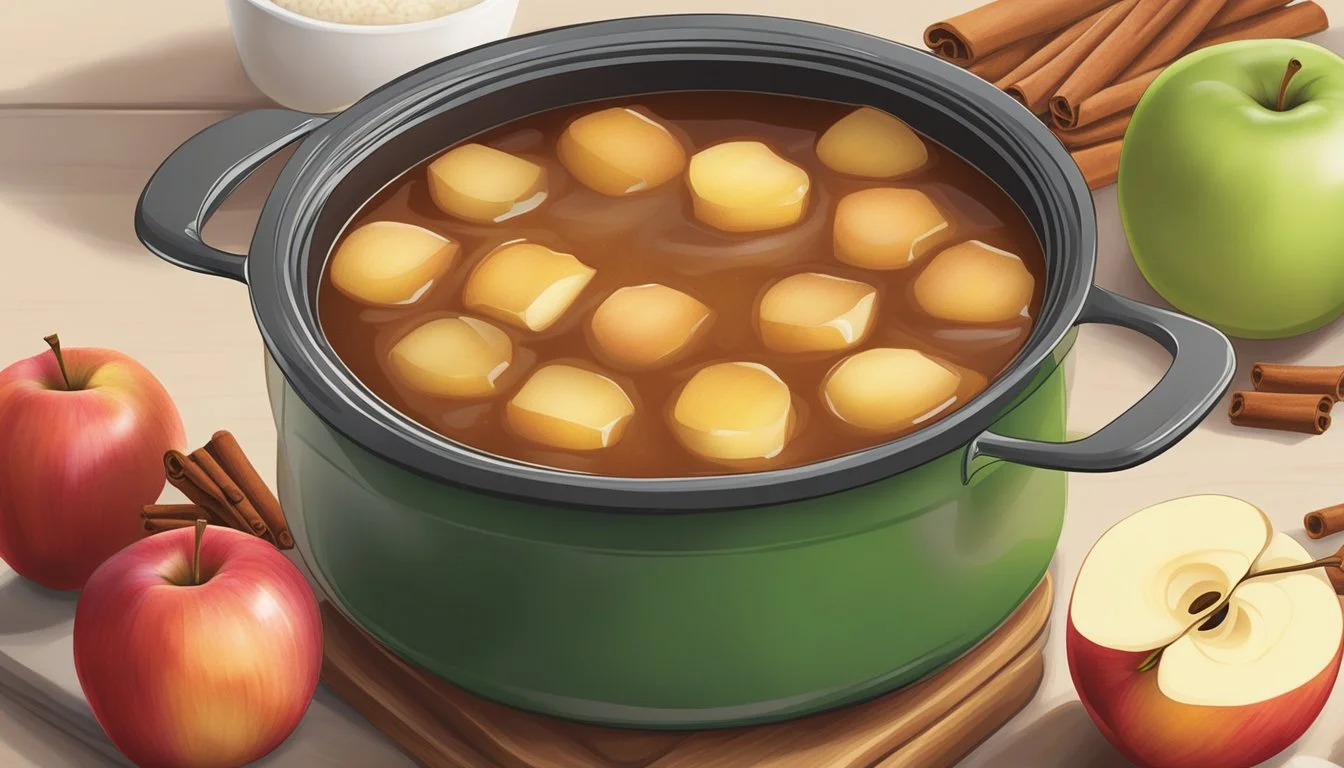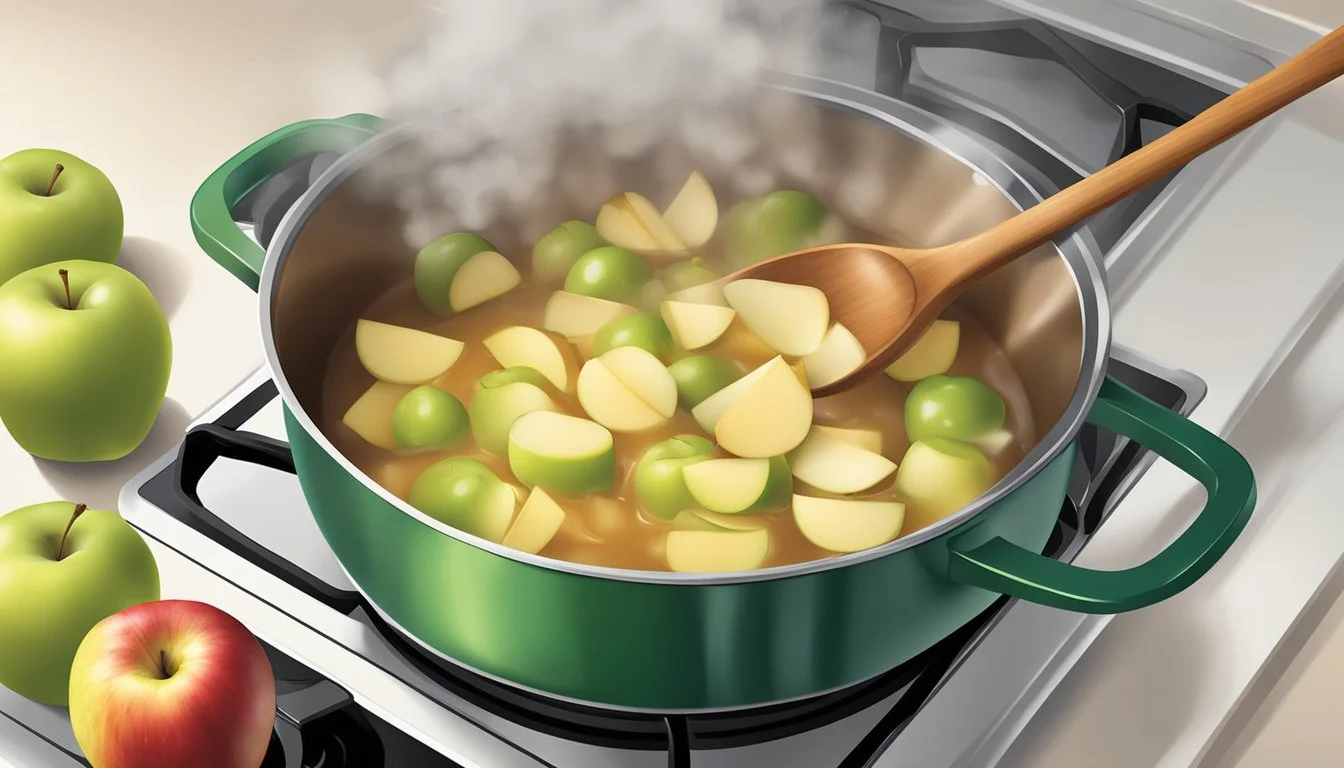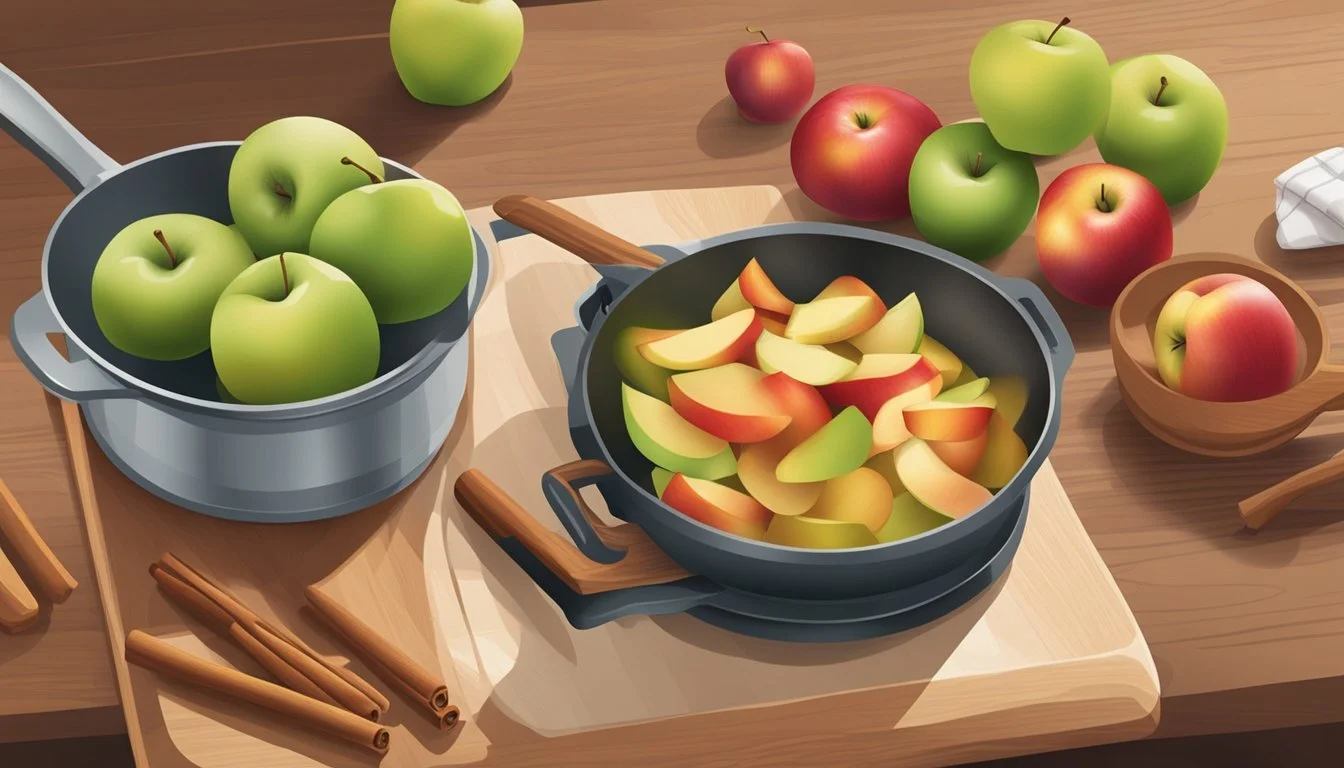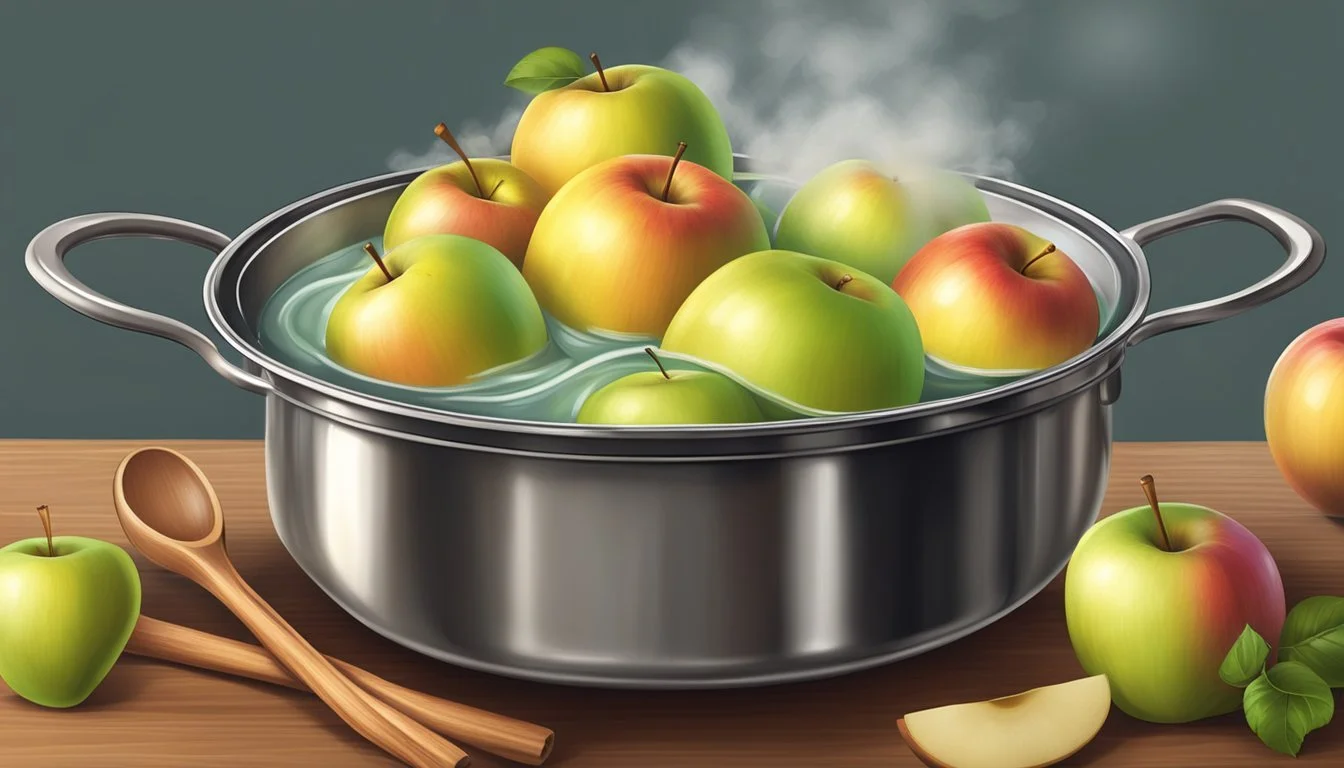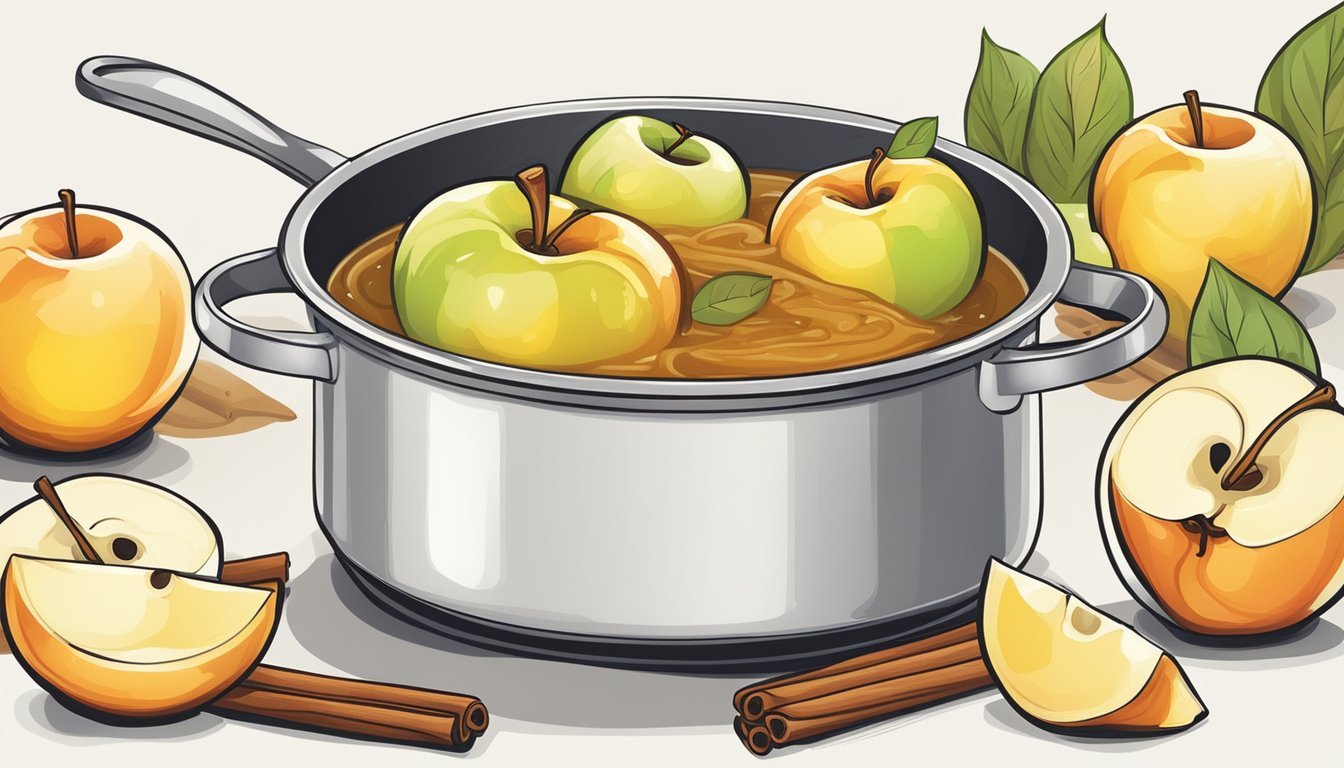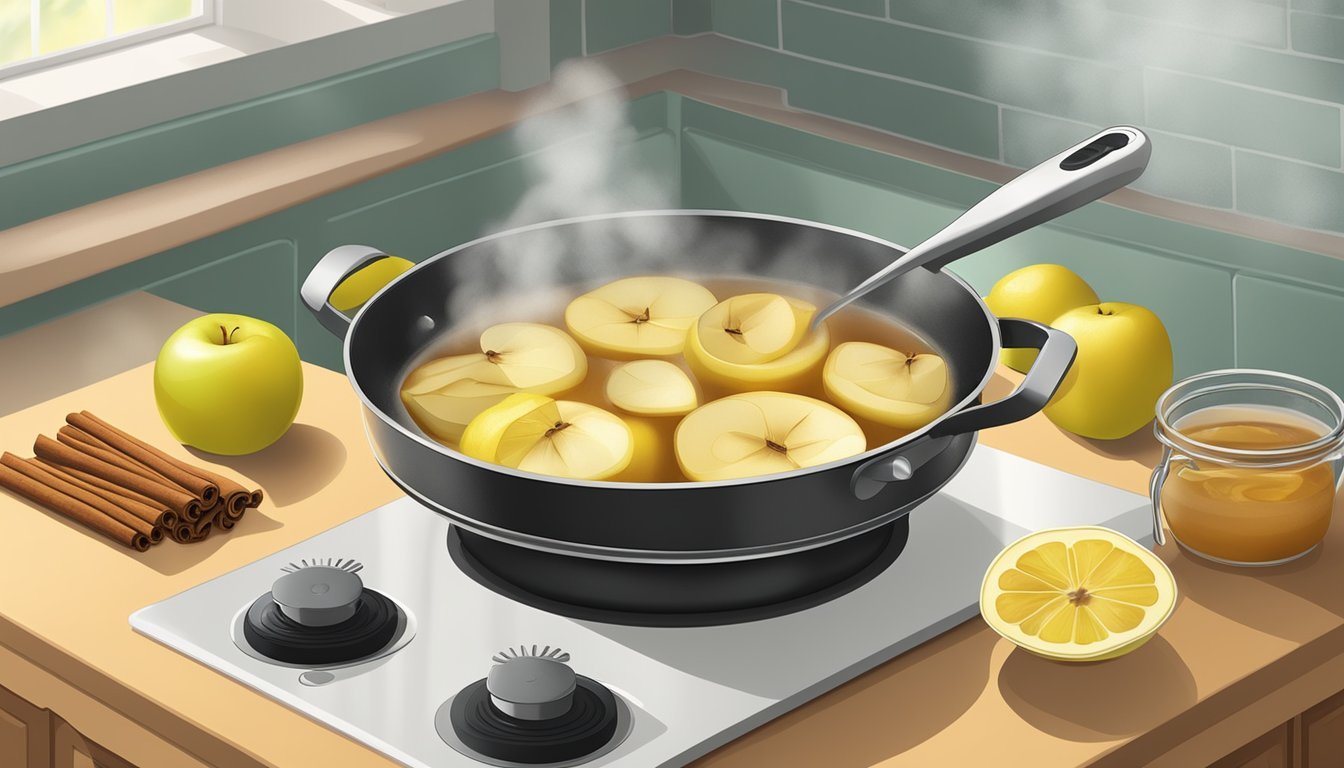The Stovetop Apple Sauce Simplified
Achieving Homemade Taste Without a Food Mill
Making homemade applesauce on the stovetop is a simple process that brings out the natural flavors of apples without the need for specialized kitchen equipment such as a food mill. This traditional method allows cooks to easily control the texture and sweetness of the final product, catering to personal preferences and dietary requirements. The lack of a food mill is no barrier to achieving a smooth and creamy applesauce; alternatives like sieves or potato mashers can suffice in creating the desired consistency.
Stovetop applesauce begins with selecting the right type of apples. Varieties such as Empire and Pink Lady are favorable due to their flavor and the lovely hue they lend to the sauce. The apples are peeled, cored, and cut into equal-size pieces to ensure even cooking. Water, sugar, and a squeeze of lemon juice may be added to the pot to enhance the taste and prevent oxidation.
The cooking process is crucial in developing the applesauce's texture. The apples are simmered on low heat to allow them to break down slowly, and if desired, additional flavors like cinnamon can be introduced. Once the apples have softened, the heat can be adjusted according to whether a chunkier sauce or a more refined puree is preferred. The resulting applesauce is a testament to the simplicity of the ingredients and the effectiveness of stovetop preparation.
Selecting the Right Apples
The success of stovetop applesauce hinges on the choice of apples. They influence the texture and sweetness of the final product.
Types of Apples
When crafting homemade applesauce, understanding the different apple types is crucial. Apples fall into three categories: sweet, tart, and a blend of both. For a well-balanced flavor, cooks often mix varieties. Gala apples are sweet and fine-textured, ideal for a smooth applesauce. Fuji apples, also on the sweeter side, contribute a uniquely crisp, juicy texture. The McIntosh variety, tart but tender, breaks down easily during cooking, which can eliminate the need for a food mill. Granny Smith apples are tart and firm, which adds a zesty punch and slightly chunky consistency if preferred. Braeburn apples balance sweet and tart, and they maintain their shape well, suitable for a thicker sauce.
Apple Season Varieties
Applesauce can be made year-round, but the best flavors come from apples in their peak season. In general, apple season spans from late summer through early winter. Gala apples are typically harvested from late summer to early fall. Fuji apples are best picked in the late fall. McIntosh apples reach their peak in early fall, a perfect time for applesauce-making. Granny Smith apples are harvested in late fall, offering a tart choice for sauce nearing winter. Lastly, Braeburn apples are collected from late fall to early winter, ensuring a rich flavor for sauces made in the colder months. By choosing apples that are in season, the applesauce is guaranteed to have the freshest taste and highest nutritional content.
Preparation Essentials
In making stovetop applesauce, the initial steps of preparing the apples are pivotal. They determine the texture and the purity of the final product. Properly peeling and coring the apples, as well as applying lemon juice to prevent oxidation, are essential practices to ensure a high-quality applesauce.
Peeling and Coring
To start, one needs to peel and core the apples effectively. Peeling removes the outer skin, which can alter the texture of the sauce, while coring eliminates the hard center and seeds.
Peeling: Use a vegetable peeler or a sharp knife. Make sure to remove all the skin without taking too much of the apple flesh.
Coring: A corer is handy, or one can simply cut the apple into quarters and remove the core with a knife.
The apples should be both peeled and cored before moving on to cooking to guarantee smoothness in the sauce's consistency.
Applying Lemon Juice
Once the apples are peeled and cored, one should promptly apply lemon juice. This step is important to preserve the color and freshness of the apples.
Immediate application: Brush or spritz lemon juice onto the freshly peeled and cored apples to prevent them from browning.
Amount: Typically, the juice of half a lemon is sufficient for a batch of applesauce, depending on the quantity of apples.
By incorporating lemon juice, the apples retain their vibrant color and a pleasant tartness that balances the sweetness.
Crafting Your Applesauce Base
Creating a homemade applesauce begins with establishing the perfect base, a process that involves careful attention to cooking times and water proportions. This foundation sets the stage for a delightful blend of texture and flavor.
Cooking Process
One begins by placing the chosen apples—peeled, cored, and chopped—into a large pot. The cook sets the stove to a medium heat and covers the pot to let the apples simmer. The simmering process is crucial as it gently coaxes the apples to soften, making them easier to mash later on. The cook time is typically about 15 to 20 minutes, or until the apples are tender enough to be easily pierced with a fork.
Cook over medium heat
Cover pot to simmer
Stir occasionally
Cook time: 15-20 minutes
Apples are done when fork-tender
Water Proportions
Water is essential to the applesauce base, providing the necessary moisture for the apples to cook down without burning. A standard measure is approximately 1 1/2 cups of water for a batch using about 4 to 6 large apples. The chef adds the water to the pot along with the apples at the beginning of the cooking process. The exact amount may be adjusted based on the type of apples used and personal preference for the applesauce's thickness.
1 1/2 cups of water for 4-6 large apples
Added at the start of cooking
Adjust as necessary for desired consistency
Flavor Enhancement
The right balance of sweetness and spices can transform homemade applesauce from a simple puree to a delightful treat. Accurate measurements and careful incorporation of these flavor enhancers are key.
Sweetness Options
When it comes to sweetening stovetop applesauce, options range from sugars to natural sweeteners. Refined white sugar is a common choice for its neutral sweetness. However, for those seeking natural alternatives, honey can provide a rich, nuanced sweetness. The following table provides sweetener options and suggested measurements for a batch using 6 apples:
Sweetener Measurement Notes White Sugar 1/4 cup Provides a clean, sweet taste Brown Sugar 1/4 cup Adds a molasses tone Honey 3 tablespoons Offers a more complex flavor
Users should adjust the quantity of sweeteners based on their personal taste preferences and the sweetness of the apples used.
Adding Spices
Spices are essential for imparting depth and aroma. Cinnamon is a classic choice and pairs well with apples, imparting a warm, comforting flavor. Nutmeg offers a more subtle, spicy undertone. Experiment with these spices to find the ideal combination for your palate. For freshly ground spices, use these recommendations:
Ground Cinnamon: Start with 1/2 teaspoon and adjust to taste.
Nutmeg: A pinch suffices, as its flavor is potent.
One can always add more but cannot remove an excess, so they should start with these conservative amounts and customize their sauce according to their preferences.
Textural Preferences
When making homemade stovetop applesauce, texture is a critical aspect, tailored to individual tastes. Getting the right consistency—whether smooth or chunky—can make all the difference in the enjoyment of the final product.
Making it Smooth
For a smooth applesauce, a blender or food processor works perfectly to puree the cooked apples into a fine, even consistency. An immersion blender can also be used directly in the saucepan for convenience, ensuring all apple pieces are sufficiently blended.
Steps to Achieve Smooth Applesauce:
Cook the apples until they are extremely tender.
Carefully transfer the cooked apples to a blender or food processor.
Blend until the desired silky consistency is achieved.
Achieving a Chunky Texture
For those who prefer a chunky applesauce, one should avoid over-processing the apples. A potato masher is an ideal tool to gently mash the apples right in the pot to control the level of chunkiness.
Method for Chunky Applesauce:
Mash the cooked apples with a potato masher until they break down into the desired size of chunks.
Brief intermissions from mashing help to assess texture and ensure it meets personal preference.
Apple Sauce Uses
Homemade apple sauce is not only delightful on its own but also serves as a versatile ingredient in various culinary applications. It can subtly enhance the flavors and textures of both sweet and savory dishes.
Dessert Applications
Apple Crisp & Baked Treats: In desserts, chefs frequently incorporate apple sauce as a healthier alternative to oil or butter, imparting moisture and a subtle apple flavor. It's particularly effective in apple streusel muffins and cake recipes, where it contributes to a tender crumb. Additionally, apple sauce can be used as a filling in pastries, providing a fruit-forward touch without overwhelming sweetness.
Breakfast Complement
Pancakes, Waffles, & French Toast: For breakfast, apple sauce acts as a natural sweetener or condiment. A dollop atop a stack of pancakes or waffles adds fruity notes and moisture, enhancing these morning favorites. It also pairs well with French toast, serving both as a topping or an ingredient in the batter to infuse the dish with apple goodness. Homemade apple sauce can elevate the most important meal of the day into something special.
Pairings with Meals
Pork & Sweet Treats: In savory dishes, apple sauce traditionally complements pork, offering a sweet and tangy counterbalance to the rich flavors of the meat. Yet, its use isn't limited to the main course; it can also accompany sweet treats for a light and health-conscious end to a meal. Whether it is used as a side or an ingredient, apple sauce adds depth and character to a variety of dishes across the culinary spectrum.
Nutritional Insight
Homemade stovetop applesauce offers an array of nutritional benefits. Apples, the primary ingredient, are a rich source of fiber, which aids in digestion and can contribute to heart health. A typical serving holds about 3 grams of fiber. The calories in applesauce are moderate, with a half-cup serving containing approximately 100 calories, depending on the apple varieties used and the addition of sweeteners.
Protein and fat are present in negligible amounts, making applesauce a low-fat, protein-light choice. There is virtually no saturated fat, which is beneficial for maintaining healthy cholesterol levels. Apples bring a modest amount of potassium to the table, which is crucial for heart function and muscle contractions.
Apples are good vitamin C providers, essential for immune system support and skin health. As for calcium and iron, these nutrients are present in smaller amounts. However, the fruit contains various other nutrients and plant compounds that are beneficial to health.
Sodium content in homemade applesauce is typically low, especially if no additional salt is added during the cooking process. This aspect makes it a heart-healthy option, important for those monitoring their sodium intake.
Here's a brief breakdown:
Fiber: ~3g per half-cup serving
Calories: ~100 per half-cup serving
Protein: Negligible
Fat: Negligible
Saturated Fat: 0g
Sodium: Low
Potassium: Present
Vitamin C: Present
Calcium: Small amounts
Iron: Small amounts
When preparing applesauce at home, one can control the added sugars and ingredients, thereby optimizing its nutritional value.
Preservation Techniques
After preparing homemade stovetop applesauce, one can ensure its longevity through proper preservation techniques. These techniques are vital in maintaining the flavor and quality of the applesauce over time.
Refrigeration
Refrigeration is the simplest method for preserving stovetop applesauce. Once cooled, the applesauce should be transferred into airtight containers. It can then be kept in the fridge where the cold temperature slows down the growth of bacteria, extending the shelf life of the applesauce. Typically, refrigerated applesauce stays fresh for up to two weeks when maintained at a constant, chilled temperature.
Freezing Methods
Freezing applesauce is an effective way to preserve its taste and nutritional value for an extended period. To freeze applesauce, one should:
Let the applesauce cool to room temperature to prevent ice crystal formation.
Pack the applesauce into freezer-safe bags or containers, leaving some space to allow for expansion as it freezes.
Label the containers with the date of freezing.
Place in the freezer, where it can be stored for several months.
When one is ready to use the frozen applesauce, it should be thawed in the refrigerator overnight. It is important not to refreeze the applesauce once it has thawed, as this can affect the texture and flavor.
Special Dietary Considerations
When making stovetop applesauce, one can easily cater to various dietary needs, ensuring the delicious treat is inclusive for all to enjoy.
Gluten-Free
Applesauce is inherently gluten-free, making it a safe choice for those with celiac disease or a gluten intolerance. However, one should be vigilant about cross-contamination or additives when not making the sauce from scratch.
Vegan and Dairy-Free
Traditionally, applesauce is vegan and dairy-free, consisting primarily of apples and water. Sweeteners and spices may be added, and they typically do not contain animal-derived ingredients.
For individuals with specific dietary restrictions, here's a breakdown:
Dietary Need Considerations Gluten-Free Ensure all added ingredients are gluten-free and avoid cross-contamination. Vegan Choose plant-based sweeteners if needed, such as maple syrup or agave nectar. Dairy-Free Applesauce does not require dairy; it's inherently dairy-free.
Product Sweeteners:
Use natural sweeteners like maple syrup or date sugar to maintain the vegan quality. Avoid honey if catering to a strict vegan diet.
One can also opt for no added sweeteners, relying on the apples' natural sweetness.
Spices:
Cinnamon and nutmeg are common spice additions that are both vegan and gluten-free. They enhance flavor without compromising dietary considerations.
By staying mindful of these specific dietary needs, one ensures the homemade applesauce is a comforting and inclusive dish that anyone can savor.
Comparative Analysis
When comparing homemade stovetop applesauce to store-bought varieties, one must consider factors like taste and nutrient retention. These comparisons can guide consumers in choosing the best option for their needs.
Homemade vs. Store-Bought
Making applesauce at home allows for complete control over ingredients, which often leads to a fresher taste and the absence of preservatives. Store-bought applesauce, while convenient, may contain additional sugars and additives to extend shelf life. Here, the homemade version typically excels in flavor, as it can be customized to personal preferences regarding sweetness, texture, and spice.
Homemade Store-Bought Customizable sweetness Often contains added sugars No preservatives May contain preservatives Fresher taste Consistent but less fresh flavor
Nutrient Retention
Nutrients in applesauce are affected by the cooking method and the presence of additives. Homemade applesauce, cooked briefly on the stove, tends to retain more of the fruit's vitamins and minerals compared to the longer processing times of commercial production. Furthermore, homemade versions avoid preservatives and stabilizers that can dilute the natural nutrient profile of the apples.
Nutrient Homemade Store-Bought Vitamins Higher retention Potential loss due to processing Minerals Higher retention Potential loss due to processing Additives None May include preservatives
Enhancing the Homemade Experience
Engaging in the preparation of homemade stovetop applesauce not only imparts a rich, personalized flavor but also envelops the home in an inviting autumnal scent. This section explores how one can heighten the enjoyment of homemade applesauce, both as a standalone dish and as a component in baking.
Serving Suggestions
For those relishing the sauce in its pure form, serving it warm can amplify its comforting qualities, making it a perfect accompaniment to fall meals. Enhancing the texture and taste, one can top their warm applesauce with a sprinkle of granola for a satisfying crunch. Here's how one might pair the applesauce:
As a breakfast: Swirl the applesauce into yogurt for a delicious morning treat.
Dessert topping: A warm spoonful atop ice cream creates a delightful contrast.
Side dish: Serve alongside pork or chicken to add a sweet element to savory dishes.
Incorporating Into Baking
When it comes to baking, applesauce serves as a versatile ingredient that introduces moisture and natural sweetness to various baked goods. One can use applesauce to partially substitute for fats like butter or oil, enhancing the nutritional profile of their baked creations. Here are some specific ways to incorporate applesauce into baking:
Muffins and quick breads: Substitute half the amount of oil with applesauce in recipes for a lighter, tender crumb.
Cookies: For softer, cake-like cookies, replace equal amounts of butter with applesauce.
Cakes: Incorporating applesauce can result in a rich, moist texture, especially in spice or fruit cakes.
Recipe Tips and Tricks
Making stovetop applesauce can be simple with a few strategic techniques to adjust consistency, balance flavors, and optimize cook time. These tips will help cooks achieve their desired applesauce texture and taste, whether they prefer it smooth or chunky.
Correcting Consistency
For smooth applesauce, if the mixture is too thick, one can gradually add a bit of water until the desired texture is achieved. For a silkier consistency, using a blender or immersion blender can help puree the applesauce to perfection. If the applesauce is too runny, allowing it to simmer uncovered can reduce the liquid and thicken it up.
For chunky applesauce, one should monitor the apples while they cook to ensure they don't over-soften. Reducing the cook time allows the apple pieces to maintain their shape, resulting in a heartier texture.
Balancing Flavors
The key to flavorful applesauce lies in the balance of sweetness and acidity. A dash of lemon juice can brighten the flavors without overwhelming the natural sweetness of the apples. If the applesauce is too tart, a small amount of sugar can be added gradually, tasting as one goes to achieve perfect harmony.
To enhance the applesauce's richness, a small amount of oil or butter can be stirred in at the end of cooking. This addition should be used sparingly to maintain the fruit's starring role.
Optimizing Cooking Time
Cook time is essential for perfect applesauce. Starting with a lower heat allows the sugars in the apples to gradually release, enhancing the sauce's flavor. Once the apples have softened, increasing the heat can hasten the cooking process and help achieve the desired consistency.
Prep time can be reduced by using ready-prepped apples or employing an efficient method for peeling and coring. The use of certain apple varieties that naturally break down quickly, like McIntosh or Golden Delicious, can also decrease the overall cook time.
Comprehensive Recipe Guide
Ingredients:
Apples: 6 medium-sized, peeled, cored, and cut into chunks
Water: 1/4 cup to help cooking
Sugar: 1/4 cup (optional)
Cinnamon: 1 stick or 1 teaspoon ground (optional)
Lemon Juice: 1 tablespoon to prevent browning (optional)
Instructions:
Combine apples and water in a large saucepan over medium heat. If opting for a sweeter taste, include sugar. For a spiced flavor, add cinnamon.
Cover the saucepan and let the apples cook for about 15 minutes, or until they are fork-tender.
After cooking, remove the cover and continue cooking for an additional 10-15 minutes to allow the mixture to thicken.
Optional: Add lemon juice to maintain the apples' color and tanginess.
Once the apples are soft, remove from heat and allow to cool slightly.
Transfer the cooked apple mixture to a blender or food processor. Pulse until it reaches the preferred consistency, whether smooth or chunky.
No Food Mill? No Problem!: Use a sieve to strain the apples if desired. This will render a finer purée or remove excess liquid from chunkier applesauce.
Cooking Tip: Keep a close eye on the mixture to prevent burning and stir occasionally. Adjust the heat as needed to ensure even cooking.
Servings: This recipe yields approximately 4 cups of applesauce.
Remember, the additional ingredients like sugar and cinnamon are optional based on one's taste preference. The simplicity of this recipe allows for customization in creating a homemade flavor that can be adjusted to satisfy any palate.
Conclusion
Creating homemade stovetop applesauce is a straightforward process that allows for complete control over the flavor profile, transforming simple apples into a deliciously sweet, tart, or balanced tangy condiment. Utilizing just a few kitchen tools like a saucepan and a sieve or a potato masher, anyone can prepare this classic side dish without needing a food mill.
The desired consistency and texture can be achieved with careful mashing, and the intensity of flavors can be customized. For a sweeter applesauce, cooks might consider choosing naturally sweet apple varieties or adding a touch of sugar. To enhance the tanginess, one might add lemon juice, adjusting the amount to taste.
It's essential to select the right type of apples—tart apples will add a sharper flavor, whereas sweet apples will create a richer, more mellow taste. A combination of both can yield a well-rounded applesauce.
Cooking times may vary, but allowing the apples to simmer until fork-tender is a reliable indicator that the fruit is ready to be mashed.
In summary, homemade stovetop applesauce is a rewarding and adaptable recipe that can accompany a range of dishes or be enjoyed on its own. Its simplicity is matched by the satisfaction of producing a homemade good with fresh ingredients, tailored to personal preferences.


